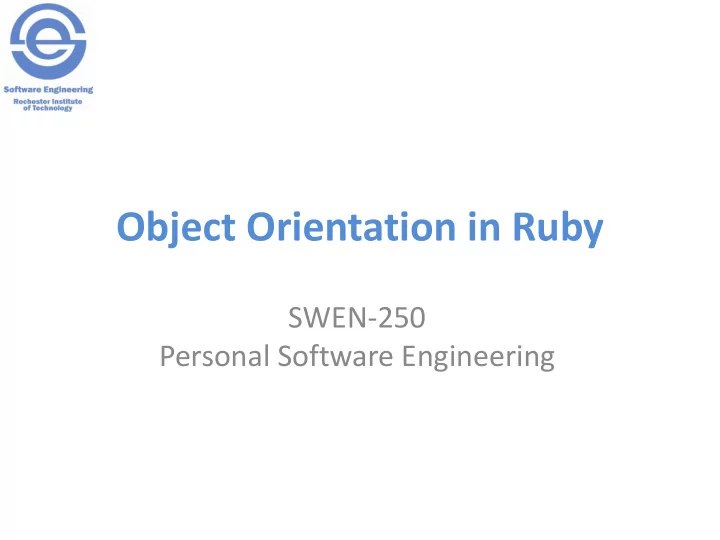

Object Orientation in Ruby SWEN-250 Personal Software Engineering
Declaring a Class class Point . . . end • Technically "Point" is a constant (as is any other entity whose name begins with a capital. • By default, the super-class of Point is "Object." • Note – we can extend a class at any point by simply opening it up and adding behavior • Do so very carefully.
Creating an Object in a Class p = Point. new (x, y) • new is a class method (like static in Java). • It allocates space and calls the initialize method in of the new object. • initialize looks like a constructor, but it is just a method called by the new class method. • Since Ruby is dynamically typed, there is no way to create multiple initialize methods.
Initialization class Point def initialize(x , y) @x = x ; @y = y end end • Arguments to initialize: x and y • @x and @y are object instance variables. • Instance variables are private – to access you need setters and getters – see below • Class variables (rarely used) are prefixed by @@ • Global variables (even rarer) are prefixed by $ • Instance variables & arguments begin with a lower case letters.
Default Arguments class Point def initialize( x = 0, y = 0 ) @x = x ; @y = y end end • p = Point.new – p is initialized to the origin. • p = Point.new(5) – p is initialized to (5, 0). • p = Point.new(3, 7) – p is initialized to (3, 7)
Setters & Getters – The Wrong Way class Point def initialize(x = 0, y = 0) @x = x ; @y = y end def x @x end def x=(newx) @x = newx end end
Setters & Getters – The Right Way class Point def initialize(x = 0, y = 0) @x = x ; @y = y end attr_accessor :x, :y end • attr_accessor is a method that takes symbols and – defines instance variables from those symbols – defines the setter and getter methods • For more control: attr_reader and attr_writer • The previous form can be used for "pseudo" variables • Example: rho & theta for polar coordinates
Other Instance Methods class Point def move_by(deltax, deltay) @x += deltax ; @y += deltay self # hmmmm??? end def move_to(other_point) @x = other_point.x ; @y = other_point.y self end def to_s#override default converter to String "(#{@x}, #{@y})" end end
Class Methods & Variables class Point @@count = 0 def initialize(x = 0, y = 0) @@count += 1 @x =x ; @y =y end def Point.count @@count end end
ON TO THE ACTIVITY
Recommend
More recommend